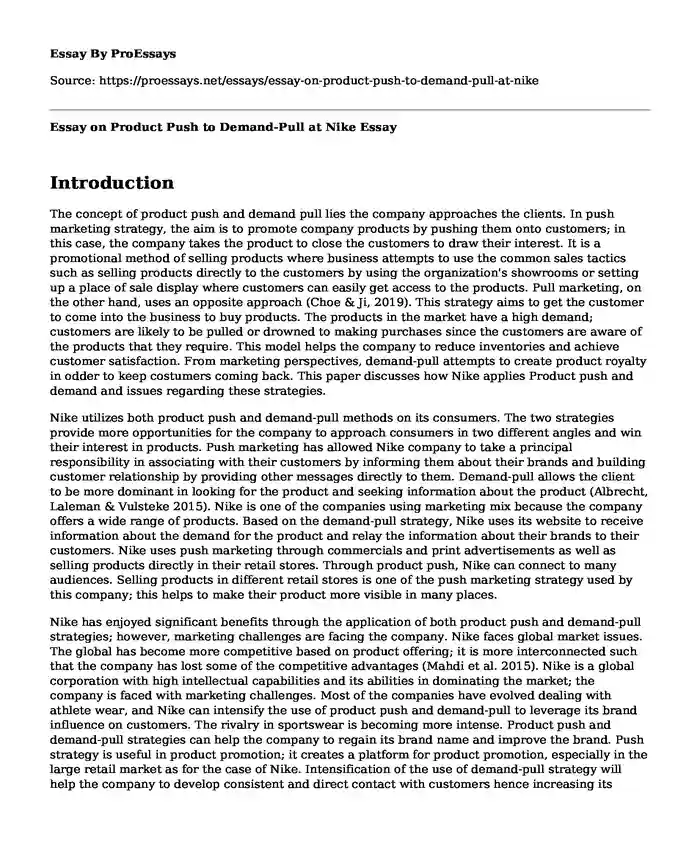Introduction
The concept of product push and demand pull lies the company approaches the clients. In push marketing strategy, the aim is to promote company products by pushing them onto customers; in this case, the company takes the product to close the customers to draw their interest. It is a promotional method of selling products where business attempts to use the common sales tactics such as selling products directly to the customers by using the organization's showrooms or setting up a place of sale display where customers can easily get access to the products. Pull marketing, on the other hand, uses an opposite approach (Choe & Ji, 2019). This strategy aims to get the customer to come into the business to buy products. The products in the market have a high demand; customers are likely to be pulled or drowned to making purchases since the customers are aware of the products that they require. This model helps the company to reduce inventories and achieve customer satisfaction. From marketing perspectives, demand-pull attempts to create product royalty in odder to keep costumers coming back. This paper discusses how Nike applies Product push and demand and issues regarding these strategies.
Nike utilizes both product push and demand-pull methods on its consumers. The two strategies provide more opportunities for the company to approach consumers in two different angles and win their interest in products. Push marketing has allowed Nike company to take a principal responsibility in associating with their customers by informing them about their brands and building customer relationship by providing other messages directly to them. Demand-pull allows the client to be more dominant in looking for the product and seeking information about the product (Albrecht, Laleman & Vulsteke 2015). Nike is one of the companies using marketing mix because the company offers a wide range of products. Based on the demand-pull strategy, Nike uses its website to receive information about the demand for the product and relay the information about their brands to their customers. Nike uses push marketing through commercials and print advertisements as well as selling products directly in their retail stores. Through product push, Nike can connect to many audiences. Selling products in different retail stores is one of the push marketing strategy used by this company; this helps to make their product more visible in many places.
Nike has enjoyed significant benefits through the application of both product push and demand-pull strategies; however, marketing challenges are facing the company. Nike faces global market issues. The global has become more competitive based on product offering; it is more interconnected such that the company has lost some of the competitive advantages (Mahdi et al. 2015). Nike is a global corporation with high intellectual capabilities and its abilities in dominating the market; the company is faced with marketing challenges. Most of the companies have evolved dealing with athlete wear, and Nike can intensify the use of product push and demand-pull to leverage its brand influence on customers. The rivalry in sportswear is becoming more intense. Product push and demand-pull strategies can help the company to regain its brand name and improve the brand. Push strategy is useful in product promotion; it creates a platform for product promotion, especially in the large retail market as for the case of Nike. Intensification of the use of demand-pull strategy will help the company to develop consistent and direct contact with customers hence increasing its strength in the market. Nike can overcome these issues by balancing pull and push marketing strategies.
References
Albrecht, J., Laleman, R., & Vulsteke, E. (2015). Balancing demand-pull and supply-push measures to support renewable electricity in Europe. Renewable and Sustainable Energy Reviews, 49, 267-277.
Choe, W. J., & Ji, I. (2019). The Performance of Supply-Push Versus Demand-Pull Technology Transfer and the Role of Technology Marketing Strategies: The Case of a Korean Public Research Institute. Sustainability, 11(7), 2005.
Mahdi, H. A. A., Abbas, M., Mazar, T. I., & George, S. (2015). A Comparative Analysis of Strategies and Business Models of Nike, Inc. and Adidas Group with special reference to Competitive Advantage in the context of a Dynamic and Competitive Environment. International Journal of Business Management and Economic Research, 6(3), 167-177.
Cite this page
Essay on Product Push to Demand-Pull at Nike. (2022, Mar 16). Retrieved from https://proessays.net/essays/essay-on-product-push-to-demand-pull-at-nike
If you are the original author of this essay and no longer wish to have it published on the ProEssays website, please click below to request its removal:
- Apple's Generic Strategy and Growth Strategies
- Importance of Becoming a Global Citizen Essay
- Essay Sample on Rights and Responsibilities of Employees
- Talent Management: Recruiting, Hiring, Training & Retaining Talent - Essay Sample
- Work-Life Balance: Its Role in HR and Employee Well-Being - Essay Sample
- Free Essay Example on 14 Principles of Management
- Japanese Yen Crisis - Research Paper Sample







